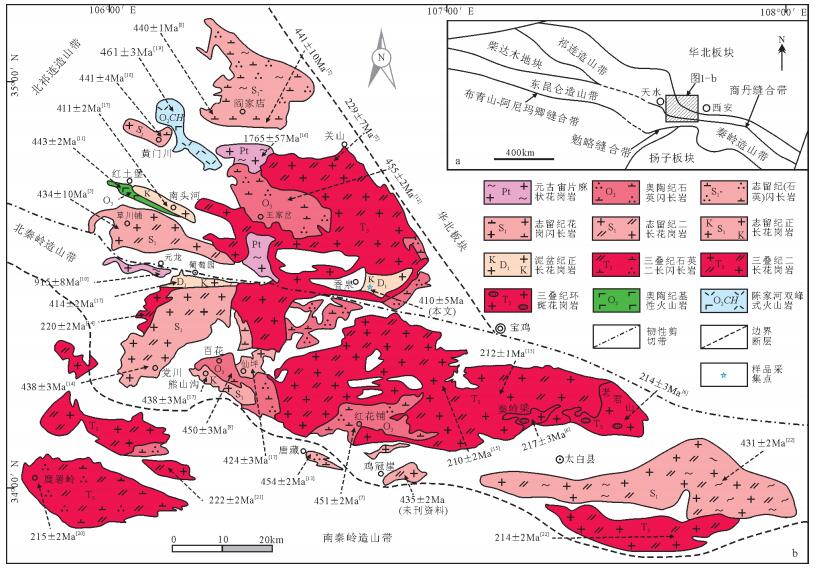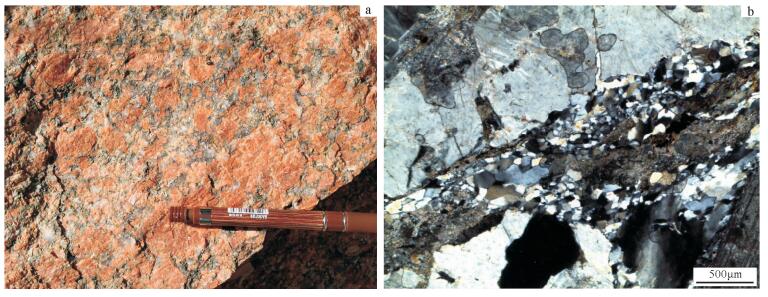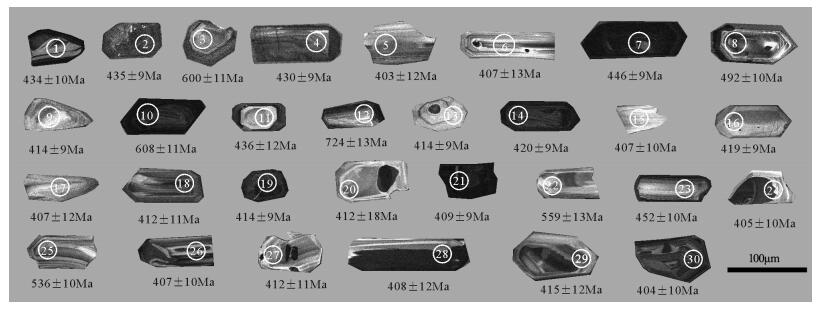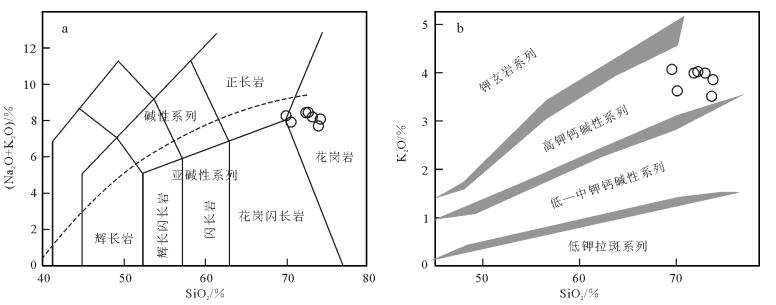Age and geochemical features of the Early Devonian Xiangquan A-type syenogranites from Baoji area at the conjunction of Qinling and Qilian Orogen and their tectonic significance
-
摘要:
对秦祁结合部位宝鸡地区香泉正长花岗岩进行了LA-ICP-MS锆石U-Pb年龄和岩石地球化学研究。结果显示,锆石206Pb/238Pb年龄加权平均值为410±5Ma(MSWD=0.20,n=18),限定该岩体的形成时代为早泥盆世。香泉正长花岗岩具有高硅(SiO2=69.63%~73.94%)、富钾(K2O=4.24%~4.88%,K2O/Na2O=1.23~1.44)、富铁(TFe2O3=2.10%~3.70%,TFe2O3/MgO=3.88~6.84)、低镁(MgO=0.31%~0.94%)、低磷(P2O5=0.08%~0.21%)的特征,属准铝质、高钾钙碱性系列。香泉正长花岗岩稀土元素含量较高(318×10-6~499×10-6),表现出明显的负Eu异常(δEu=0.37~0.46),富集Rb、Th、Zr、Sm、Ga(10000×Ga/Al=2.59~2.93)等微量元素,贫Ba、Nb、Ta、Sr,整体表现出A型花岗岩特征。结合区域资料认为,香泉正长花岗岩形成于造山后环境,为低压环境下长英质地壳物质部分熔融成因。
Abstract:Xiangquan syengranites are located in Baoji area at the conjunction of Qinling and Qilian Orogen, and their LA-ICPMS zircon U-Pb geochronological and petrogeochemical studies were conducted in this paper. The results show that the zircon 206Pb/238Pb weighted average age of Xiangquan syengranites is 410±5Ma (MSWD=0.20, n=18), indicating that the crystallization age of the syengranites is Early Devonian. Xiangquan syengranites are high in SiO2 (SiO2=69.63%~73.94%), K2O (K2O=4.24%~4.88%, K2O/Na2O=1.23~1.44), and TFe2O3 (TFe2O3=2.10%~3.70%, TFe2O3/MgO=3.88~6.84), but low in MgO (MgO=0.31%~0.94%) and P2O5(P2O5=0.08%~0.21%), belonging to high-K calc-alkaline series with metaluminous features. In addition, they are enriched in total REE (318×10-6~499×10-6), with obvious negative Eu anomaly (δEu=0.37~0.46). The trace elements show enrichement of Rb, Th, Zr, Sm and Ga (10000×Ga/Al=2.59~2.93), depletion of Ba, Nb, Ta and Sr, with the characteristics of A-type granites on the whole. Combined with regional data, the authors hold that the Xiangquan syenogranites were formed in a post-orogenic tectonic setting and derived from partially melted felsic crust under low pressures.
-
花岗岩的成因类型和形成时代是探讨地壳生长和地球动力学背景的重要指示标志[1-2]。在中央造山系,分布有元古宙—中新生代不同类型、不同成因的花岗岩类[3-4]。宝鸡岩体位于华北板块、祁连造山带和北秦岭造山带构造交接部位的(图 1-a),由于其独特的构造位置,近年来倍受地学界关注。不同学者在宝鸡岩体内解体出元古宙、加里东期、中新生代等不同时代、不同成因的岩浆岩类[5-22],其中加里东期岩浆记录类型尤为丰富(图 1-b),记录了早古生代天水-武山主洋盆俯冲、陆缘弧形成、陆缘弧裂解、弧后盆地打开、弧后盆地俯冲、全面碰撞造山、后碰撞调整的过程,但后碰撞调整结束的时间节点仍缺乏较多的年代学支撑。本文首次正式报道了宝鸡岩体内存在泥盆纪A型正长花岗岩,获得其结晶年龄为410±5Ma(MSWD=0.20,n=18),属早泥盆世早期,形成于造山后环境,指示秦祁结合部位在早泥盆世早期已经完成后碰撞调整,全面进入造山后演化阶段。
1. 区域地质背景
香泉正长花岗岩体是本次研究新发现的一套正长花岗岩体,位于北祁连造山带东端秦祁结合部位,与中晚三叠世关山岩体呈侵入接触关系,西部被白垩系三桥组(K1s)不整合覆盖。关山岩体主体为一套肉红色中-粗粒(含)斑状二长花岗岩,局部可见肉红色细粒二长花岗岩,三桥组为一套陆相复成分砾岩、砂砾岩沉积。香泉含斑中粗粒正长花岗岩新鲜面为肉红色,风化色为灰白色-浅肉红色,具似斑状结构,斑晶主要为钾长石(约3%),主体呈他形,粒径为8~30mm,基质由碱性长石(约55%)、斜长石(约13%)、石英(约27%)、黑云母(约5%)组成,颗粒大小不等,主体粒径为0.15~5mm。碱性长石为微斜长石、正长石、条纹长石,微斜长石呈他形,表面多具轻微粘土化;正长石呈他形,表面具粘土化;条纹长石呈半自形板状。斜长石呈半自形板状,聚片双晶发育,见双晶纹弯曲。石英呈他形,与长石颗粒呈镶嵌状,具波状消光。岩石受动力作用发生碎裂,碎粉呈条带状定向分布或环绕碎块分布,局部碎块呈眼球状,见微裂隙杂乱分布,裂隙被方解石、硅质充填。
2. 测试方法
本文样品在陕西省地质矿产实验研究所(国土资源部西安矿产资源监督检测中心)进行主量、稀土和微量元素分析测试。主量元素用电感耦合等离子体原子发射光谱仪(ICP-AES,型号为iCAP 6300)进行分析,分析流程参照GB/T 14506—2010,分析精度优于1%。稀土元素采用电感耦合等离子质谱仪(ICP-MS,型号为X Series 2)进行分析,分析流程参照GB/T 17417—2010。微量元素用ZSX Primus Ⅱ型X射线荧光光谱仪(X射线荧光光谱法)、IRIS Intrepid Ⅱ XSP型等离子体发射光谱仪(等离子体发射光谱法)、X Series Ⅱ型等离子体质谱仪(ICP-MS)测试,分析精度为5%~10%。
锆石分选在河北省廊坊市地源矿物测试分选技术服务有限公司完成。锆石阴极发光(CL)显微照相在西北大学大陆动力学国家重点实验室Gatan MonoCL3+X型阴极荧光谱仪上完成。锆石U-Pb同位素测试在西安地质调查中心的LA-ICP-MS仪器上进行,分析仪器为美国Agilent公司生产的Agilent 7700x四极杆型质谱仪和德国相干公司(Coherent)生产的Geolas Pro 193nm准分子型激光剥蚀系统。激光剥蚀束斑直径为30μm,剥蚀深度为20~ 40μm。单个分析点的同位素比值和年龄误差为1σ,锆石年龄采用206Pb/238U年龄,年龄加权平均值具有95%的置信度。
3. LA-ICP-MS锆石U-Pb定年
测年样品XQ-1的地理坐标为北纬34°29.958′、东经106°45.856′。测年样品为肉红色含斑中粗粒正长花岗岩,锆石晶体呈浅黄色-无色,粒径介于40~ 170μm之间,大部分颗粒较小,呈自形浑圆状-短柱状,约占样品总颗粒的2/3,部分呈长柱状,颗粒较大,约占1/3。锆石CL图像(图 3)显示,大部分锆石生长环带较清晰,部分锆石晶体有少量溶蚀,破裂明显,发育核幔结构。选取30颗锆石进行LA-ICP-MS测定,分析结果见表 1,其中03、08、10、12、22、25号点谐和度较差,剔除不用,选取其余24颗谐和度较好的锆石进行分析。24颗锆石数据点(01~02、04~07、09、11、13~21、23~24、26~30号点)在U-Pb谐和图(图 4-a)上可分为2组。第一组锆石(1、2、4、7、11、23号点)206Pb/238U年龄为451~431Ma,Th/U值为0.17~2.12。该组锆石普遍发育核幔结构,测点全部在核部,指示其为捕获锆石。第二组锆石(05、06、09、13~21、24、26~30号点)206Pb/238U年龄为420~ 403Ma,Th、U含量较高,分别为147×10-6~1064×10-6、88×10-6~1081×10-6,Th/U值为0.36~2.59(除19号测点外,全部大于0.4)。该组锆石生长环带清晰,不发育核幔结构,为岩浆成因锆石[23-24],206Pb/238U年龄加权平均值为410 ± 5Ma(MSWD=0.20,n=18)(图 4-b)。该年龄可解释为花岗岩的结晶年龄,即香泉正长花岗岩形成于早泥盆世早期。
表 1 香泉正长花岗岩(样品XQ-1)LA-ICP-MS锆石U-Th-Pb同位素分析结果Table 1. LA-ICP-MS zircon U-Th-Pb isotopic analytical data of Xiangquan syenogranites(sample XQ-1)测点编号 206Pb 232Th 238U Th/U 206Pb/238U 207Pb/235U 207Pb/206Pb 206Pb/238U 207Pb/235U 207Pb/206Pb 谐和度/% 10-6 比值 1σ 比值 1σ 比值 1σ 年龄/Ma 1σ 年龄/Ma 1σ 年龄/Ma 1σ 1 64 88 218 0.41 0.0697 0.0018 0.5331 0.016 0.0556 0.0015 434 10 434 11 437 58 100 2 343 199 1164 0.17 0.0699 0.0017 0.5341 0.013 0.0556 0.0012 435 9 436 10 435 45 100 3 150 314 520 0.60 0.0686 0.0017 0.8058 0.020 0.0854 0.0018 600 11 428 10 1325 40 71 4 131 162 450 0.36 0.0691 0.0017 0.5270 0.013 0.0555 0.0012 430 9 431 10 431 47 100 5 32 270 118 2.30 0.0646 0.0017 0.4873 0.018 0.0549 0.0020 403 12 403 10 407 77 100 6 28 218 103 2.12 0.0649 0.0017 0.4928 0.019 0.0552 0.0020 407 13 405 10 421 79 100 7 551 1159 1854 0.62 0.0707 0.0017 0.5510 0.013 0.0567 0.0011 446 9 440 10 478 44 99 8 75 609 257 2.37 0.0698 0.0017 0.6227 0.017 0.0649 0.0015 492 10 435 10 770 48 88 9 59 331 212 1.56 0.0663 0.0017 0.5033 0.014 0.0551 0.0014 414 9 414 10 418 53 100 10 242 717 819 0.88 0.0704 0.0017 0.8202 0.020 0.0846 0.0018 608 11 439 10 1307 40 72 11 29 148 100 1.48 0.0703 0.0018 0.5367 0.018 0.0555 0.0017 436 12 438 11 431 67 100 12 56 382 190 2.02 0.0705 0.0018 1.0402 0.027 0.1073 0.0024 724 13 439 11 1754 40 61 13 95 201 344 0.59 0.0663 0.0017 0.5028 0.013 0.0551 0.0013 414 9 414 10 418 50 100 14 200 774 722 1.07 0.0662 0.0016 0.5116 0.013 0.0562 0.0012 420 9 413 10 459 46 98 15 41 387 149 2.59 0.0656 0.0017 0.4935 0.015 0.0546 0.0015 407 10 410 10 397 60 101 16 109 491 387 1.27 0.0673 0.0017 0.5108 0.014 0.0552 0.0013 419 9 420 10 418 52 100 17 30 147 110 1.33 0.0655 0.0017 0.4933 0.017 0.0547 0.0018 407 12 409 10 401 71 100 18 32 242 115 2.10 0.0659 0.0017 0.4997 0.016 0.0551 0.0016 412 11 411 10 416 64 100 19 225 289 813 0.36 0.0664 0.0016 0.5038 0.013 0.0551 0.0012 414 9 414 10 418 46 100 20 24 184 88 2.08 0.0663 0.0019 0.5000 0.026 0.0548 0.0029 412 18 414 12 403 113 101 21 292 1064 1081 0.98 0.0651 0.0016 0.4955 0.013 0.0553 0.0013 409 9 406 10 424 50 99 22 26 203 95 2.14 0.0666 0.0017 0.7339 0.022 0.0800 0.0022 559 13 415 10 1198 52 74 23 52 367 173 2.12 0.0725 0.0018 0.5612 0.016 0.0562 0.0014 452 10 451 11 459 56 100 24 45 258 166 1.55 0.0649 0.0016 0.4894 0.015 0.0547 0.0015 405 10 406 10 401 59 100 25 39 219 136 1.61 0.0689 0.0017 0.6952 0.020 0.0733 0.0019 536 12 429 11 1022 51 80 26 39 206 143 1.44 0.0653 0.0017 0.4937 0.015 0.0548 0.0016 407 10 408 10 405 63 100 27 41 320 149 2.15 0.0661 0.0017 0.4998 0.016 0.0548 0.0016 412 11 413 10 405 63 100 28 41 206 152 1.36 0.0656 0.0017 0.4942 0.017 0.0547 0.0018 408 12 409 10 400 72 100 29 53 297 192 1.54 0.0667 0.0018 0.5045 0.018 0.0549 0.0019 415 12 416 11 409 73 100 30 65 344 245 1.41 0.0646 0.0016 0.4889 0.014 0.0549 0.0015 404 10 403 10 410 58 100 4. 岩石地球化学
4.1 主量元素
本文所测7个样品的主量、稀土、微量元素含量及特征值见表 2、表 3。香泉正长花岗岩的SiO2含量为69.63%~73.94%,平均值为72.14%,TiO2含量为0.22%~0.62%,Na2O含量为3.39%~3.60%,K2O含量为4.24% ~4.88%,Al2O3含量为13.57% ~14.87%,TFe2O3含量为2.10%~3.70%,MgO含量为0.31%~ 0.94%,P2O5含量为0.08%~0.21%。AR指数为2.34~2.71,平均值为2.60,σ指数为1.93~2.56,平均值为2.28,属钙碱性系列,K2O/Na2O值为1.23~1.44,为钾质。A/CNK值为1.00~1.06,平均值为1.03,属准铝质。碱铝指数(AKI)为0.73~0.79,TFe2O3/MgO值为3.88~6.84。Mg#值为20.68~31.50,平均值为26.00。在SiO2-(Na2O + K2O)图解[25](图 5-a)及SiO2-K2O图解[26](图 5-b)中,香泉正长花岗岩表现出高钾钙碱性花岗岩特征。整体看,香泉正长花岗岩具有高硅、富钾、低镁、低钛、低磷的主量元素特征,属准铝质、高钾钙碱性系列。
表 2 香泉正长花岗岩主量元素分析结果Table 2. Major elements analytical data of Xiangquan syenogranites% 样品号 SiO2 TiO2 Al2O3 TFe2O3 MnO MgO CaO Na2O K2O P2O5 烧失量 总量 XQ-1 71.16 0.28 13.94 2.88 0.07 0.50 1.53 3.56 4.77 0.11 1.42 100.22 XQ-2 71.35 0.28 13.83 2.70 0.07 0.43 1.51 3.50 4.80 0.10 1.29 99.86 XQ-3 72.15 0.27 13.83 2.59 0.07 0.41 1.28 3.35 4.77 0.09 1.16 99.97 XQ-4 73.02 0.22 13.40 2.31 0.06 0.30 1.43 3.35 4.58 0.09 1.05 99.81 XQ-5 72.92 0.23 13.62 2.43 0.06 0.40 1.49 3.42 4.19 0.08 1.26 100.10 XQ-6 69.38 0.61 13.86 4.06 0.09 0.93 1.94 3.47 4.31 0.21 1.30 100.15 XQ-7 68.68 0.52 14.67 3.58 0.08 0.83 1.95 3.34 4.81 0.17 1.32 99.95 表 3 香泉正长花岗岩稀土、微量元素分析结果Table 3. Rare earth and trace element analytical data of Xiangquan syenogranites10-6 样品号 La Ce Pr Nd Sm Eu Gd Tb Dy Ho Er Tm Yb Lu Ba Rb Ga Ni XQ-1 82.8 170 18.6 57.7 8.88 1.04 7.48 1.17 5.84 1.10 3.49 0.54 3.36 0.56 775 211 20.5 5.28 XQ-2 93.3 192 20.9 64.9 9.91 1.16 8.31 1.35 6.76 1.31 4.03 0.64 4.10 0.65 844 228 21.0 4.35 XQ-3 88.9 181 19.8 61.6 9.28 1.06 7.75 1.24 6.19 1.20 3.64 0.57 3.79 0.62 772 218 20.6 5.08 XQ-4 73.6 148 16.3 51.7 8.28 1.04 7.12 1.20 6.33 1.20 3.65 0.57 3.69 0.57 713 204 20.9 4.05 XQ-5 71.4 144 16.0 50.3 8.10 0.96 7.08 1.31 7.30 1.40 4.29 0.68 4.35 0.66 671 184 21.4 4.86 XQ-6 110 233 26.1 83.3 12.5 1.73 10.6 1.61 8.14 1.56 4.71 0.69 4.54 0.71 1098 183 21.3 7.13 XQ-7 96.2 201 21.9 69.9 10.7 1.49 8.80 1.36 6.82 1.32 4.02 0.61 3.92 0.65 1159 180 20.4 7.17 样品号 Cr Hf Sc Ta Co U Pb Cs Zr Nb Th Sr Y δEu δCe (La/Yb)N (La/Sm)N (Gd/Yb)N XQ-1 8.72 5.93 3.79 3.43 5.50 4.77 28.6 1.41 222 27.8 48.4 198 34.6 0.38 1.00 16.61 5.87 1.80 XQ-2 9.56 6.05 4.17 3.76 4.81 8.01 31.4 1.65 228 30.6 44.7 205 40.5 0.38 1.01 15.34 5.92 1.64 XQ-3 43.7 6.34 3.65 3.90 3.19 4.18 26.2 1.66 231 29.3 45.7 206 36.5 0.37 1.00 15.81 6.03 1.65 XQ-4 8.99 6.08 3.27 3.70 3.24 4.75 34.2 1.69 198 28.8 38.8 212 36.0 0.40 0.99 13.45 5.59 1.56 XQ-5 9.50 5.72 3.13 2.15 3.80 5.30 42.4 1.56 193 28.9 35.8 223 42.5 0.38 0.99 11.07 5.54 1.31 XQ-6 9.94 3.28 6.06 4.12 5.53 3.15 28.0 1.91 295 34.3 31.0 367 47.0 0.45 1.01 16.34 5.54 1.88 XQ-7 15.3 3.76 5.67 4.16 5.94 3.92 87.9 2.20 287 32.0 35.6 355 40.3 0.46 1.02 16.55 5.66 1.81 4.2 稀土和微量元素
香泉正长花岗岩的稀土元素总量(∑REE)为318×10-6~499×10-6,平均值为390×10-6,轻/重稀土元素比值(∑LREE/∑HREE)为10.74~14.59。球粒陨石标准化稀土元素配分曲线(图 6-a)显示,稀土元素配分曲线整体右倾呈“海鸥式”分布,(La/Yb)N值为11.07~16.61,(La/Sm)N值为5.54~6.03,重稀土元素分异不明显,(Gd/Yb)N值为1.31~1.88。δEu(0.37~ 0.46)平均值为0.40,负Eu异常明显,暗示了斜长石分离结晶的发生或源区大量斜长石的残留。δCe(0.99~1.02)平均为1.00,未表现出Ce异常。香泉正长花岗岩原始地幔标准化微量元素蛛网图整体右倾(图 6-b),富集Rb、U等大离子亲石元素及Th、La、Nd、Zr、Hf、Sm、Y等惰性元素。与相邻元素相比,表现出Ba、K、Nb、Ta、Ce、Sr、P、Ti谷。Ba和Sr的同步亏损可能是由于斜长石的分离结晶作用或岩浆起源于斜长石稳定区导致的,P和Ti的亏损可能是由于磷灰石和钛铁矿的分离结晶作用或岩浆起源于磷灰石和钛铁矿稳定区导致的。样品Rb/Sr值为0.50~1.11,平均值为0.86;Rb/Nb值为5.34~7.59,平均值为6.70;Nb/Ta值为7.52~ 13.44,平均值为8.72;Nb/La值为0.31~0.40,平均值为0.35。香泉正长花岗岩稀土及微量元素标准化曲线与天水地区葡萄园早泥盆世A型正长花岗岩[17](图 6阴影部分)十分相似,二者位于新阳-元龙韧性剪切带两侧且距离较近,暗示其具有相似的地质意义。
![]() 图 6 香泉正长花岗岩稀土元素球粒陨石标准化配分曲线(a)和微量元素原始地幔蛛网图(b)(标准化数据据参考文献[27])Figure 6. Chondrite-normalized REE patterns (a) and primitive mantle normalized spidergrams (b) of Xiangquan syenogranites
图 6 香泉正长花岗岩稀土元素球粒陨石标准化配分曲线(a)和微量元素原始地幔蛛网图(b)(标准化数据据参考文献[27])Figure 6. Chondrite-normalized REE patterns (a) and primitive mantle normalized spidergrams (b) of Xiangquan syenogranites5. 讨论
5.1 岩石类型及成因
香泉正长花岗岩具有高硅、富钾、低镁、低钛、低磷的特征,TFe2O3/MgO值(3.88~6.84)及碱铝指数(0.73~0.79)较高,与A型花岗岩主量元素特征类似[28]。香泉正长花岗岩相对富集Rb、Th、Zr、Nd、Zr、Hf、Y等元素,Sr、Ba、Cr、Co、Ni等元素含量较低,其10000×Ga/Al值介于2.59~2.93之间,平均值为2.81,高于I型花岗岩和S型花岗岩的平均值(分别为2.10、2.28),主体高于A型花岗岩的下限值2.60[28],与葡萄园A型花岗岩(2.34~2.78)接近[17]。元素Zr+Nb+Ce+Y含量为408×10-6~609× 10-6,高于A型花岗岩下限值(350×10-6)[28],在10000× Ga/Al与Ce、Y、Nb、Na2O+K2O图解及Zr+Nb+Ce+ Y与(K2O+Na2O)/CaO、TFe2O3/MgO图解中,香泉正长花岗岩样品整体落入A型花岗岩区域内(图 7),且与葡萄园A型正长花岗岩较接近。
![]() 图 7 香泉正长花岗岩岩石类型判别图解(底图据参考文献[28])Figure 7. Rock type discrimination diagrams of Xiangquan syenogranites
图 7 香泉正长花岗岩岩石类型判别图解(底图据参考文献[28])Figure 7. Rock type discrimination diagrams of Xiangquan syenogranites由于高分异I、S型花岗岩地球化学特征与A型花岗岩十分相似,因此有必要对其进行区分。相比A型花岗岩,高分异的S型花岗岩具有更高的P2O5含量(平均值为0.14%)和更低的Na2O含量(平均值为2.81%)[29];高分异的I型花岗岩则具有更低的TFe2O3含量(<1.00%)、Ga/Al值和更高的Rb含量(>270×10-6)[30]。香泉正长花岗岩较低的P2O5含量(平均值为0.12%)和较高的Na2O含量(平均值为3.47%)区别于高分异的S型花岗岩;较高的TFe2O3含量(平均为2.67%)和较低的Rb含量(平均值为201.14×10-6)区别于高分异的I型花岗岩。整体看,香泉正长花岗岩具有A型花岗岩的地球化学特征。
关于A型花岗岩的成因主要有以下4种观点:① 由幔源碱性岩浆的分离结晶作用形成[31-32];② 花岗质溶体抽离后的富F、Cl下地壳麻粒岩相残留体在高压下的低程度部分熔融作用形成[33];③ 幔源岩浆与深熔形成的壳源岩浆的混合与交代作用形成[34-35];④ 由长英质岩石在地壳浅部脱水部分熔融形成[36-37]。区域上缺乏与香泉正长花岗岩同期形成的中基性侵入岩,且香泉正长花岗岩Nb/Ta值(平均值为8.72)、Nb/La值(平均值为0.35)、Rb/Sr值(平均值为0.86)、Rb/Nb值(平均值为6.70)与幔源岩浆(分别为17.39~17.78、0.93~1.32、0.01~0.05、0.24~0.89)差异较大[27],因而由幔源岩浆的分离结晶作用形成的可能性不大。前人实验岩石学研究表明,下地壳麻粒岩相物质部分熔融后可形成富铝贫碱、富镁贫钛耐熔残余下地壳,这种残余下地壳的部分熔融不可能生成A型花岗质岩浆[37-38]。野外调查过程中,香泉正长花岗岩内未发现中基性岩包体,因而壳幔混合成因模型也不可能是其主要形成机制。总之,前3种成因模型不能很好地解释香泉A型正长花岗岩的成因。
前人研究表明,由长英质地壳岩石中含水矿物的脱水熔融形成的花岗岩基本上都属于铝质A型,形成深度一般不会大于30km,压力一般小于4kbar,而碱性花岗岩则为相对干的幔源镁铁质岩浆分异的产物[37, 39-40]。香泉A型正长花岗岩未见暗色碱性矿物,具有准铝质、高钾钙碱性特征,亏损Sr、Ba,负Eu异常明显,重稀土元素较平坦,指示岩浆源区为富集斜长石且无石榴子石残留的浅部低压区域[41]。香泉正长花岗岩Nb/U值(平均值为6.75)和Rb/Nb值(平均值为6.70)均介于平均中、上地壳之间(平均中、上地壳Nb/U值分别为7.69、4.44,Rb/ Nb值分别为6.50、6.83),Nb/La值(平均值为0.35)与平均上地壳(0.39)接近[42],暗示其岩浆源区主要为壳源岩浆。由上述分析推测,低压下长英质地壳物质的部分熔融模型很可能是香泉A型花岗岩的主要形成机制。
5.2 构造环境
研究表明,A型花岗岩主要形成于造山后或非造山伸展的构造环境[43-44]。A型花岗岩可细分为非造山(A1)和后造山(A2)2类。它们具有不同的物质来源,并分别代表不同的大地构造环境,其中,A1型来源于似大洋岛屿玄武岩侵入于大陆裂谷,或在板内岩浆作用期间侵入,为大陆岩石圈稳定之后的拉张,是裂谷活动开始的征兆;A2型花岗岩则起源于经历了陆-陆碰撞或岛弧岩浆作用的陆壳或板下地壳物质的部分熔融,标志着造山作用结束后不久即开始拉张,其规模和深度均较小,是造山作用结束的标志。香泉A型花岗岩具有较高的Y(平均值为40×10-6)、Nb(平均值为30×10-6)、Rb(平均值为201×10-6)含量和Y/Nb值(1.24~1.47)。在(Y+Nb)-Rb图解[45](图 8-a)中,全部落入后碰撞花岗岩区域;在Y/Nb-Rb/Nb图解[44](图 8-b)中,全部落入A2型花岗岩区域,表明香泉A型正长花岗岩属于A2型,形成于造山后的拉张环境。
5.3 构造意义
在西秦岭地区,代表原特提斯分支天水-武山主洋盆存在的记录为关子镇洋脊型蛇绿岩,形成时代为534~489Ma[46-47]。天水-武山洋盆在早奥陶世开始由南向北俯冲,在西秦岭地区形成以李子园群、草滩沟群、斜峪关群为代表的大陆岛弧-弧前盆地火山-沉积岩系[48-49],同时形成小王涧、桦林沟、鸳鸯镇具俯冲性质的基性-中性-中酸性侵入岩和武山-鸳鸯镇、细尾子沟、伯阳SSZ型蛇绿岩组合,总体时限为472~440Ma[50-52]。宝鸡岩体的百花、唐藏、红花铺等俯冲性质中基性(杂)岩为主洋盆俯冲阶段的岩浆记录,形成时代为454~450Ma[7, 9, 13]。
随着天水-武山主洋盆的北向俯冲,北祁连东端地区,在陆缘弧基础上经历了陆缘弧初始裂陷、弧后盆地初始扩张和弧后盆地俯冲3个过程;① 陆缘弧初始裂陷阶段(472~462Ma),随着主洋盆的俯冲,在以秦岭群和陇山群为代表的活动大陆边缘基底上形成以陈家河群双峰式火山岩(447± 8Ma)[51]和黄门川花岗闪长岩(457±3Ma)[19]为代表的活动大陆边缘初始裂陷型岩浆记录;② 弧后盆地初始扩张阶段(462~454Ma),随着活动陆缘的进一步拉张,大陆边缘弧进一步拉张裂解,玄武质岩浆沿着先形成的岩浆通道缓慢向上运移,经过一定的岩浆演化到达前部岩浆房,并在陈家河群火山岩-沉积岩系南侧的红土堡—凤阁岭一带喷出就位,形成红土堡组具枕状构造的基性火山岩及夹持的硅质岩,基性火山岩具有弧后盆地地球化学属性[51, 53],何世平等[11]获得弧后盆地演化后期的年龄为443± 2Ma;③ 弧后盆地俯冲阶段(454~440Ma),随着以红土堡组基性火山岩为代表的弧后盆地扩张,在晚奥陶世中期(454Ma)开始向北俯冲消减,在弧后盆地以北产生大量典型陆缘弧型深成侵入岩体,例如出露于张家川一带的阎家店石英闪长岩体(441~440Ma)[5, 8]、王家岔石英闪长岩体(455±2Ma)[12]及陕西陇县地区的新街花岗质片麻岩(448±5Ma)[54],其地球化学特征显示出与俯冲作用密切相关的火山弧型花岗岩类。
北祁连造山带东端及邻区于早志留世早期(440Ma左右)大规模的古洋壳俯冲消减结束,开始转入陆-陆或陆-弧碰撞阶段,该时段持续到424Ma左右。先在陆缘弧基础上裂解形成的弧后盆地全面闭合,南边的主洋盆也可能已经闭合。该阶段研究区内沉积了一套葫芦河群具碰撞性质的复理石建造,同时碰撞型花岗质岩较发育,如草川铺碰撞型二长花岗岩(434±10Ma)[5]、党川碰撞型二长花岗岩(438±3Ma)[14]、熊山沟碰撞型二长花岗岩体(438±3Ma)[17]、太白北部碰撞型二长花岗岩(431± 2Ma)[22]。这些岩体的年代学资料反映,加里东期大规模碰撞型花岗质岩浆侵入活动主要发生在438~ 424Ma期间,与区域加里东晚期(志留纪)的碰撞汇聚造山作用密切相关。在碰撞造山过程中,随着以红土堡为代表的弧后盆地收缩闭合,在红土堡组基性火山岩南侧沉积了一大套葫芦河复理石相碎屑岩,沉积时限大致为早志留世,与碰撞型花岗岩的形成时代一致。
随着板块碰撞造山的结束,区域上在早志留世末(约428Ma)进入后碰撞阶段。伴随着岩石圈伸展垮塌,在靠近板块碰撞带的仙坪一带形成了仙坪壳幔混合型高分异I型花岗岩(424±3Ma)[17]。随着岩石圈的进一步伸展,幔源镁铁质岩浆底侵下地壳,下地壳物质减压熔融,形成西秦岭北缘的葡萄园造山后A型花岗岩(414±2Ma)和北祁连东端的南头河造山后A型花岗岩(411±2Ma)[17]。本次获得的早泥盆世香泉正长花岗岩属高硅、富钾、低镁、低钛、低磷的准铝质、高钾钙碱性系列,具有较高的TFe2O3/ MgO、Ga/Al值和碱铝指数,富集Rb、Th、Zr、Nd、Zr、Hf、Y,相对亏损Sr、Ba,Cr、Co、Ni,反映出造山后A型花岗岩(A2)特征,并获得其结晶年龄为410± 5Ma(MSWD=0.20,n=18),与葡萄园A型花岗岩具有相近的岩石学、地球化学和年代学特征,是西秦岭微板块与华北板块碰撞造山结束后岩浆底侵作用导致大陆地壳垂向生长过程的岩浆记录,指示区域造山在早泥盆世早期已经结束,预示着新一轮构造演化的开始。
总的来看,宝鸡岩体含有不同时代、不同属性的岩浆岩年龄信息,主要包括元古宙汇聚型片麻状花岗岩、加里东期多类型岩浆岩及印支期后碰撞型花岗岩。其中,加里东期岩浆记录主要是天水-武山洋盆在中晚奥陶世北向俯冲阶段形成的陆缘弧型中基性(杂)岩,陆缘弧基础上裂解形成的裂解型火山岩(花岗岩)、MORB型火山岩,弧后盆地俯冲型岩浆岩,主洋盆和弧后盆地闭合后形成的早志留世碰撞型花岗岩,以及早泥盆世造山结束阶段形成的造山后环境A型花岗岩。
6. 结论
(1)香泉正长花岗岩为高硅、富钾、低镁、低钛、低磷的准铝质、高钾钙碱性岩石,富集Rb、Th、Zr、Sm、Ga,贫Ba、Nb、Ta、Sr,整体表现出造山后A2型花岗岩特征,为低压环境下长英质地壳物质部分熔融的产物。
(2)香泉造山后正长花岗岩形成时代为410± 5Ma(MSWD=0.20,n=18),属早泥盆世早期,指示秦祁结合部位早泥盆世早期已经完成后碰撞调整,全面进入造山后阶段。
致谢: 审稿专家对本文提出许多宝贵意见和建议,在此谨致谢忱。 -
图 6 香泉正长花岗岩稀土元素球粒陨石标准化配分曲线(a)和微量元素原始地幔蛛网图(b)(标准化数据据参考文献[27])
Figure 6. Chondrite-normalized REE patterns (a) and primitive mantle normalized spidergrams (b) of Xiangquan syenogranites
图 7 香泉正长花岗岩岩石类型判别图解(底图据参考文献[28])
Figure 7. Rock type discrimination diagrams of Xiangquan syenogranites
表 1 香泉正长花岗岩(样品XQ-1)LA-ICP-MS锆石U-Th-Pb同位素分析结果
Table 1 LA-ICP-MS zircon U-Th-Pb isotopic analytical data of Xiangquan syenogranites(sample XQ-1)
测点编号 206Pb 232Th 238U Th/U 206Pb/238U 207Pb/235U 207Pb/206Pb 206Pb/238U 207Pb/235U 207Pb/206Pb 谐和度/% 10-6 比值 1σ 比值 1σ 比值 1σ 年龄/Ma 1σ 年龄/Ma 1σ 年龄/Ma 1σ 1 64 88 218 0.41 0.0697 0.0018 0.5331 0.016 0.0556 0.0015 434 10 434 11 437 58 100 2 343 199 1164 0.17 0.0699 0.0017 0.5341 0.013 0.0556 0.0012 435 9 436 10 435 45 100 3 150 314 520 0.60 0.0686 0.0017 0.8058 0.020 0.0854 0.0018 600 11 428 10 1325 40 71 4 131 162 450 0.36 0.0691 0.0017 0.5270 0.013 0.0555 0.0012 430 9 431 10 431 47 100 5 32 270 118 2.30 0.0646 0.0017 0.4873 0.018 0.0549 0.0020 403 12 403 10 407 77 100 6 28 218 103 2.12 0.0649 0.0017 0.4928 0.019 0.0552 0.0020 407 13 405 10 421 79 100 7 551 1159 1854 0.62 0.0707 0.0017 0.5510 0.013 0.0567 0.0011 446 9 440 10 478 44 99 8 75 609 257 2.37 0.0698 0.0017 0.6227 0.017 0.0649 0.0015 492 10 435 10 770 48 88 9 59 331 212 1.56 0.0663 0.0017 0.5033 0.014 0.0551 0.0014 414 9 414 10 418 53 100 10 242 717 819 0.88 0.0704 0.0017 0.8202 0.020 0.0846 0.0018 608 11 439 10 1307 40 72 11 29 148 100 1.48 0.0703 0.0018 0.5367 0.018 0.0555 0.0017 436 12 438 11 431 67 100 12 56 382 190 2.02 0.0705 0.0018 1.0402 0.027 0.1073 0.0024 724 13 439 11 1754 40 61 13 95 201 344 0.59 0.0663 0.0017 0.5028 0.013 0.0551 0.0013 414 9 414 10 418 50 100 14 200 774 722 1.07 0.0662 0.0016 0.5116 0.013 0.0562 0.0012 420 9 413 10 459 46 98 15 41 387 149 2.59 0.0656 0.0017 0.4935 0.015 0.0546 0.0015 407 10 410 10 397 60 101 16 109 491 387 1.27 0.0673 0.0017 0.5108 0.014 0.0552 0.0013 419 9 420 10 418 52 100 17 30 147 110 1.33 0.0655 0.0017 0.4933 0.017 0.0547 0.0018 407 12 409 10 401 71 100 18 32 242 115 2.10 0.0659 0.0017 0.4997 0.016 0.0551 0.0016 412 11 411 10 416 64 100 19 225 289 813 0.36 0.0664 0.0016 0.5038 0.013 0.0551 0.0012 414 9 414 10 418 46 100 20 24 184 88 2.08 0.0663 0.0019 0.5000 0.026 0.0548 0.0029 412 18 414 12 403 113 101 21 292 1064 1081 0.98 0.0651 0.0016 0.4955 0.013 0.0553 0.0013 409 9 406 10 424 50 99 22 26 203 95 2.14 0.0666 0.0017 0.7339 0.022 0.0800 0.0022 559 13 415 10 1198 52 74 23 52 367 173 2.12 0.0725 0.0018 0.5612 0.016 0.0562 0.0014 452 10 451 11 459 56 100 24 45 258 166 1.55 0.0649 0.0016 0.4894 0.015 0.0547 0.0015 405 10 406 10 401 59 100 25 39 219 136 1.61 0.0689 0.0017 0.6952 0.020 0.0733 0.0019 536 12 429 11 1022 51 80 26 39 206 143 1.44 0.0653 0.0017 0.4937 0.015 0.0548 0.0016 407 10 408 10 405 63 100 27 41 320 149 2.15 0.0661 0.0017 0.4998 0.016 0.0548 0.0016 412 11 413 10 405 63 100 28 41 206 152 1.36 0.0656 0.0017 0.4942 0.017 0.0547 0.0018 408 12 409 10 400 72 100 29 53 297 192 1.54 0.0667 0.0018 0.5045 0.018 0.0549 0.0019 415 12 416 11 409 73 100 30 65 344 245 1.41 0.0646 0.0016 0.4889 0.014 0.0549 0.0015 404 10 403 10 410 58 100 表 2 香泉正长花岗岩主量元素分析结果
Table 2 Major elements analytical data of Xiangquan syenogranites
% 样品号 SiO2 TiO2 Al2O3 TFe2O3 MnO MgO CaO Na2O K2O P2O5 烧失量 总量 XQ-1 71.16 0.28 13.94 2.88 0.07 0.50 1.53 3.56 4.77 0.11 1.42 100.22 XQ-2 71.35 0.28 13.83 2.70 0.07 0.43 1.51 3.50 4.80 0.10 1.29 99.86 XQ-3 72.15 0.27 13.83 2.59 0.07 0.41 1.28 3.35 4.77 0.09 1.16 99.97 XQ-4 73.02 0.22 13.40 2.31 0.06 0.30 1.43 3.35 4.58 0.09 1.05 99.81 XQ-5 72.92 0.23 13.62 2.43 0.06 0.40 1.49 3.42 4.19 0.08 1.26 100.10 XQ-6 69.38 0.61 13.86 4.06 0.09 0.93 1.94 3.47 4.31 0.21 1.30 100.15 XQ-7 68.68 0.52 14.67 3.58 0.08 0.83 1.95 3.34 4.81 0.17 1.32 99.95 表 3 香泉正长花岗岩稀土、微量元素分析结果
Table 3 Rare earth and trace element analytical data of Xiangquan syenogranites
10-6 样品号 La Ce Pr Nd Sm Eu Gd Tb Dy Ho Er Tm Yb Lu Ba Rb Ga Ni XQ-1 82.8 170 18.6 57.7 8.88 1.04 7.48 1.17 5.84 1.10 3.49 0.54 3.36 0.56 775 211 20.5 5.28 XQ-2 93.3 192 20.9 64.9 9.91 1.16 8.31 1.35 6.76 1.31 4.03 0.64 4.10 0.65 844 228 21.0 4.35 XQ-3 88.9 181 19.8 61.6 9.28 1.06 7.75 1.24 6.19 1.20 3.64 0.57 3.79 0.62 772 218 20.6 5.08 XQ-4 73.6 148 16.3 51.7 8.28 1.04 7.12 1.20 6.33 1.20 3.65 0.57 3.69 0.57 713 204 20.9 4.05 XQ-5 71.4 144 16.0 50.3 8.10 0.96 7.08 1.31 7.30 1.40 4.29 0.68 4.35 0.66 671 184 21.4 4.86 XQ-6 110 233 26.1 83.3 12.5 1.73 10.6 1.61 8.14 1.56 4.71 0.69 4.54 0.71 1098 183 21.3 7.13 XQ-7 96.2 201 21.9 69.9 10.7 1.49 8.80 1.36 6.82 1.32 4.02 0.61 3.92 0.65 1159 180 20.4 7.17 样品号 Cr Hf Sc Ta Co U Pb Cs Zr Nb Th Sr Y δEu δCe (La/Yb)N (La/Sm)N (Gd/Yb)N XQ-1 8.72 5.93 3.79 3.43 5.50 4.77 28.6 1.41 222 27.8 48.4 198 34.6 0.38 1.00 16.61 5.87 1.80 XQ-2 9.56 6.05 4.17 3.76 4.81 8.01 31.4 1.65 228 30.6 44.7 205 40.5 0.38 1.01 15.34 5.92 1.64 XQ-3 43.7 6.34 3.65 3.90 3.19 4.18 26.2 1.66 231 29.3 45.7 206 36.5 0.37 1.00 15.81 6.03 1.65 XQ-4 8.99 6.08 3.27 3.70 3.24 4.75 34.2 1.69 198 28.8 38.8 212 36.0 0.40 0.99 13.45 5.59 1.56 XQ-5 9.50 5.72 3.13 2.15 3.80 5.30 42.4 1.56 193 28.9 35.8 223 42.5 0.38 0.99 11.07 5.54 1.31 XQ-6 9.94 3.28 6.06 4.12 5.53 3.15 28.0 1.91 295 34.3 31.0 367 47.0 0.45 1.01 16.34 5.54 1.88 XQ-7 15.3 3.76 5.67 4.16 5.94 3.92 87.9 2.20 287 32.0 35.6 355 40.3 0.46 1.02 16.55 5.66 1.81 -
王涛.花岗岩混合成因研究及大陆动力学意义[J].岩石学报, 2000, 16(2): 161-168. http://www.cnki.com.cn/Article/CJFDTOTAL-YSXB200002002.htm 肖庆辉, 邢作云, 张星, 等.当代花岗岩研究的几个重要前沿[J].地学前缘, 2003, 10(3): 222-229. http://www.cnki.com.cn/Article/CJFDTOTAL-DXQY200303032.htm 张宏飞, 靳兰兰, 张利, 等.西秦岭花岗岩类地球化学和Pb-SrNd同位素组成对基底性质及其构造属性的限制[J].中国科学(D辑), 2005, 35(10): 914-926. doi: 10.3969/j.issn.1674-7240.2005.10.002 张成立, 王涛, 王晓霞.秦岭造山带早中生代花岗岩成因及其构造环境[J].高校地质学报, 2008, 14(3): 304-316. http://www.cnki.com.cn/Article/CJFDTOTAL-GXDX200803006.htm Zhang H F, Zhang B R, Nigel Harris, et al. U-Pb zircon HRIMP ages, geochemical and Sr-Nd-Pb isotopic compositions of intrusive rocks from the Longshan-Tianshui area in the southeast corner of the Qilianorogenic belt, China: Constraints on petrogenesis and tectonicaffinity[J]. Journal of Asian Earth Sciences, 2006, 27: 751-764. doi: 10.1016/j.jseaes.2005.07.008
卢欣祥, 尉向东, 肖庆辉.秦岭环斑花岗岩的年代学研究及其意义[J].高校地质学报, 1999, 5(4): 372-377. http://www.cnki.com.cn/Article/CJFDTOTAL-GXDX199904001.htm 王洪亮, 何世平, 陈隽璐, 等.北秦岭西段红花铺俯冲性侵入岩LA-ICP-MS定年及其地质意义[J].现代地质, 2006, 20(4): 536-564. http://www.cnki.com.cn/Article/CJFDTOTAL-XDDZ200604002.htm 裴先治, 孙仁奇, 丁仨平, 等.陇东地区阎家店闪长岩LA-ICP-MS锆石U-Pb测年及其地质意义[J].中国地质, 2007, 34(1): 8-16. http://www.cnki.com.cn/Article/CJFDTOTAL-DIZI200701001.htm 裴先治, 刘战庆, 丁仨平, 等.甘肃天水地区百花岩浆杂岩的锆石LA-ICP-MS U-Pb定年及其地质意义[J].地球科学进展, 2007, 22(8): 818-827. http://www.cnki.com.cn/Article/CJFDTOTAL-DXJZ200708006.htm 裴先治, 丁仨平, 张国伟, 等.西秦岭北缘新元古代花岗质片麻岩的LA-ICP-MS锆石U-Pb年龄及其地质意义[J].地质学报, 2007, 81(6): 773-784. http://www.cnki.com.cn/Article/CJFDTOTAL-DZXE200706004.htm 何世平, 王洪亮, 徐学义, 等.北祁连东段红土堡基性火山岩锆石LA-ICP-MS U-Pb年代学及其地质意义[J].地球科学进展, 2007, 22(2): 143-151. http://www.cnki.com.cn/Article/CJFDTOTAL-DXJZ200702003.htm 陈隽璐, 李好斌, 王洪亮, 等.秦祁结合部位王家岔石英闪长岩体锆石LA-ICP-MS定年及地质意义[J].吉林大学学报(地球科学版), 2007, 37(3): 423-431. http://www.cnki.com.cn/Article/CJFDTOTAL-CCDZ200703001.htm 陈隽璐, 徐学义, 王洪亮, 等.北秦岭西段唐藏石英闪长岩岩体的形成时代及其地质意义[J].现代地质, 2008, 22(1): 63-70. http://www.cnki.com.cn/Article/CJFDTOTAL-XDDZ200801007.htm 王婧, 张宏飞, 徐旺春, 等.西秦岭党川地区花岗岩的成因及其构造意义[J].地球科学-中国地质大学学报, 2008, 33(4): 474-486. http://www.cnki.com.cn/Article/CJFDTOTAL-DQKX200804006.htm 刘树文, 杨朋涛, 李秋根, 等.秦岭中段印支期花岗质岩浆作用与造山过程[J].吉林大学学报(地球科学版), 2011, 41(6): 1928-1943. http://www.cnki.com.cn/Article/CJFDTOTAL-CCDZ201106022.htm 王银川, 裴先治, 李佐臣, 等.北祁连造山带东端张家川地区长宁驿中元古代花岗质片麻岩LA-ICP-MS锆石U-Pb年龄及其构造意义[J].地质通报, 2012, 31(10): 1576-1587. doi: 10.3969/j.issn.1671-2552.2012.10.004 王银川. 秦祁结合部位加里东期碰撞-后碰撞型花岗岩地质特征及构造意义[D]. 长安大学硕士学位论文, 2013: 1-86. http://cdmd.cnki.com.cn/Article/CDMD-11941-1014022221.htm 魏方辉, 裴先治, 李瑞保, 等.甘肃天水地区早古生代黄门川花岗闪长岩体LA-ICP-MS锆石定年及构造意义[J].地质通报, 2012, 31(9): 1496-1509. http://www.cnki.com.cn/Article/CJFDTOTAL-ZQYD201209013.htm 魏方辉. 北祁连造山带东端早古生代物质组成、变形特征及其构造演化过程[D]. 长安大学硕士学位论文, 2013: 1-130. http://cdmd.cnki.com.cn/Article/CDMD-11941-1014022227.htm 李佐臣, 裴先治, 李瑞保, 等.西秦岭糜署岭花岗岩体年代学、地球化学特征及其构造意义[J].岩石学报, 2013, 29(8): 2617-2634. http://www.cnki.com.cn/Article/CJFDTOTAL-YSXB201308001.htm 任厚州, 裴先治, 刘成军, 等.西秦岭天水地区太白花岗岩体LA-ICP-MS锆石U-Pb年龄、地球化学特征及其地质意义[J].地质通报, 2014, 33(7): 1041-1054. http://www.cnki.com.cn/Article/CJFDTOTAL-ZQYD201407011.htm 吕星球. 北秦岭太白花岗岩体年代学和成因研究[D]. 中国地质大学(北京)硕士学位论文, 2015: 1-78. http://cdmd.cnki.com.cn/Article/CDMD-11415-1015385448.htm Wu Y B, Zheng Y F. Genesis of zircon and its constraints on interpretation of U-Pb age[J]. Chinese Science Bulletin, 2004, 49(15): 1554-1569. doi: 10.1007/BF03184122
Siebel W, Blaha U, Chen F K, et al. Geochronology and geochemistry of a dyke-host rock association and implications for the formation of the Bavarian Pfahl shear zone, Bohemian Massif[J]. International Journal of Earth Sciences, 2005, 94(1): 8-23. doi: 10.1007/s00531-004-0445-0
Le Maitre R W, Bateman P, Dudek A, et al. A Classification of igneous rocks and glossary of terms[M]. Oxford: Blackwell, 1989.
Rickwood P C. Boundary lines within petologic diagrams which use oxides of major and minor element[J]. Lithos, 1989, 22(4): 247-263. doi: 10.1016/0024-4937(89)90028-5
Sun S S, McDonough W F. Chemical and isotopic systematics of oceanic basalts: Implications for mantle composition and processes [C]// Sunders A D, Norry M J. Magmatism in the Ocean Basins. London: Geol. Soc. Spec. Publ., 1989, 42: 313-345.
Whalen J B, Currie K L, Chappell B W. A-type granites: Geochemical characteristics, discrimination and petrogenesis[J]. Contributions to Mineralogy and Petrology, 1987, 95: 407-419. doi: 10.1007/BF00402202
贾小辉, 王强, 唐功建. A型花岗岩的研究进展及意义[J].大地构造与成矿学, 2009, 33(3): 465-480. http://www.cnki.com.cn/Article/CJFDTOTAL-DGYK200903020.htm 王强, 赵振华, 熊小林.桐柏-大别造山带燕山晚期A型花岗岩的厘定[J].岩石矿物学杂志, 2000, 19(4): 297-306. http://www.cnki.com.cn/Article/CJFDTOTAL-YSKW200004001.htm Turner S P, Foden J D, Morrison R S. Derivation of some A-type magmas by fractionation of basaltic magma: An example from the Padthaway Ridge, South Australia[J]. Lithos, 1992, 28: 151-179. doi: 10.1016/0024-4937(92)90029-X
Mushkin A, Navon O, Halicz L, et al. The petrogenesis of A-type magmas from the Amram Massif, southern Israel[J]. Journal of Petrology, 2003, 44: 815-832. doi: 10.1093/petrology/44.5.815
Clemens J D, Holloway J R, White A J R. Origin of an A-type granite: Experimental constrains[J]. American Mineralogist, 1986, 71: 317-324. https://www.researchgate.net/publication/279898234_Origin_of_an_A-type_granite_experimental_constraints
Harris C, Marsh J S, Milner S C. Petrology of the alkaline core of the essum igneous complex, Namibia: Evidence for the progressively decreasing effect of crustal contamination[J]. Journal of Petrology, 1999, 40: 1377-1397. doi: 10.1093/petroj/40.9.1377
Yang J H, Wu F Y, Chung S L, et al. A hybrid origin for the Qianshan A-type granite, northeast China: Geochemical and Sr-NdHf isotopic evidence[J]. Lithos, 2006, 89: 89-106. doi: 10.1016/j.lithos.2005.10.002
Skjerlie K P, Johnston A D. Vapor-absent melting at 10 kbar of a biotite-and amphibole-bearing tonalitic gneiss: Implications for the generation of A-type granites[J]. Geology, 1992, 20: 263-266. doi: 10.1130/0091-7613(1992)020<0263:VAMAKO>2.3.CO;2
Patiño Douce A E. Generation of metaluminous A-type granites by low-pressure melting of calc-alkaline granitoids[J]. Geology, 1997, 25: 743-746. doi: 10.1130/0091-7613(1997)025<0743:GOMATG>2.3.CO;2
Creaser R A, Price R C, Wormald R J. A-type granites revisited: Assessment of a residual-source model[J]. Geology, 1991, 19: 163-166. doi: 10.1130/0091-7613(1991)019<0163:ATGRAO>2.3.CO;2
King P L, White A J R, Chappell B W, et al. Characterization and origin of aluminous A-type granites from the Lachlan fold belt, southeastern Australia[J]. Journal of Petrology, 1997, 38(3): 371-391. doi: 10.1093/petroj/38.3.371
吴福元, 李献华, 杨进辉, 等.花岗岩成因研究的若干问题[J].岩石学报, 2007, 23(6): 1217-1238. http://www.cnki.com.cn/Article/CJFDTOTAL-HBDK199001002.htm Rapp R P, Watson E B. Dehydration melting of metabasalt at 8~32 kbar: Implications for continental growth and crust-mantle recycling[J]. Journal of Petrology, 1995, 36: 891-931. doi: 10.1093/petrology/36.4.891
Gao S, Rudnick R L, Yuan H L, et al. Recycling lower continental crust in the North China craton[J]. Nature, 2004, 432: 892-897 doi: 10.1038/nature03162
Whalen J B, Jenner G A, Longstaffe F J, et al. Geochemical and isotopic (O, Nd, Pb and Sr) constraints on A-type granite: Petrogenesis based on the Topsails igneous suite, Newfound land Appalachians[J]. Journal of Petrology, 1996, 37: 1463-1489. doi: 10.1093/petrology/37.6.1463
Eby G N. Chemical subdivision of the A-type granitoids: Petrogenetic and tectonic implications[J]. Geology, 1992, 20: 641-644. doi: 10.1130/0091-7613(1992)020<0641:CSOTAT>2.3.CO;2
Pearce J A. Sources and settings of granitic rock[J]. Episodes, 1996, 19(4): 120-125. https://www.researchgate.net/publication/262099137_Sources_and_settings_of_granitic_rocks
裴先治, 丁仨平, 李佐臣, 等.西秦岭北缘关子镇蛇绿岩的形成时代:来自辉长岩中LA-ICP-MS锆石U-Pb年龄的证据[J].地质学报, 2007, 81(11): 1550-1561. doi: 10.3321/j.issn:0001-5717.2007.11.010 董云鹏, 杨钊, 张国伟, 等.西秦岭关子镇蛇绿岩地球化学及其大地构造意义[J].地质学报, 2008, 82(9): 1186-1194. http://www.cnki.com.cn/Article/CJFDTOTAL-DZXE200809004.htm 裴先治, 刘会彬, 丁仨平, 等.西秦岭天水地区李子园群变质火山岩的地球化学特征及其地质意义[J].大地构造与成矿学, 2006, 30(2): 193-205. http://www.cnki.com.cn/Article/CJFDTOTAL-DGYK200602010.htm 闫全人, 王宗起, 陈隽璐, 等.北秦岭斜峪关群和草滩沟群火山岩成因的地球化学和同位素约束、SHRIMP年代及其意义[J].地质学报, 2007, 81(4): 488-500. http://www.cnki.com.cn/Article/CJFDTOTAL-DZXE200704006.htm 闫全人, 陈隽璐, 王宗起, 等.北秦岭小王涧枕状熔岩中淡色侵入岩的地球化学特征、SHRIMP年龄及地质意义[J].中国科学(D辑), 2007, 37(10): 1301-1313. http://www.cnki.com.cn/Article/CJFDTOTAL-JDXK200710005.htm 李王晔. 西秦岭-东昆仑造山带蛇绿岩及岛弧型岩浆岩的年代学和地球化学研究——对特提斯洋演化的制约[D]. 中国科学技术大学博士学位论文, 2008: 1-124. http://cdmd.cnki.com.cn/Article/CDMD-10358-2008091811.htm Pei X Z, Li Z C, Liu H B, et al. Geochemical characteristics and zircon U-Pb isotopic ages of island-arc basic igneous complexes from the Tianshui area in West Qinling[J]. Front. Earth Sci. China, 2007, 1(1): 49-59. doi: 10.1007/s11707-007-0008-3
胡波. 甘肃天水地区清水-张家川早古生代变质火山岩岩石地球化学特征及其构造意义[D]. 长安大学硕士学位论文, 2005: 1-75. http://cdmd.cnki.com.cn/article/cdmd-11941-2006030053.htm 何艳红, 陈亮, 孙勇, 等.陇县地区新街片麻岩套锆石年龄及其地质意义[J].西北大学学报(自然科学版), 2005, 35(5): 625-632. http://www.cnki.com.cn/Article/CJFDTOTAL-XBDZ200505030.htm 长安大学地质调查研究院. 1: 25万天水市幅区域地质调查(修测)报告. 2004. 陕西省地质调查院. 1: 25万宝鸡市幅区域地质调查(修测)报告. 2004.




 下载:
下载:







